
Gastropods, commonly known as slugs and snails, belong to a large taxonomic class of invertebrates within the phylum Mollusca called Gastropoda.

Jean René Constant Quoy was a French naval surgeon, zoologist and anatomist.
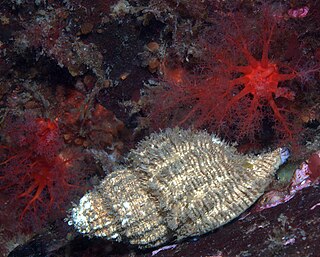
Fusitriton oregonensis is a species of large predatory sea snail, a marine gastropod mollusk in the family Cymatiidae.

An operculum is a corneous or calcareous anatomical structure like a trapdoor that exists in many groups of sea snails and freshwater snails, and also in a few groups of land snails; the structure is found in some marine and freshwater gastropods, and in a minority of terrestrial gastropods, including the families Helicinidae, Cyclophoridae, Aciculidae, Maizaniidae, Pomatiidae, etc.

Amphibola crenata is a species of air-breathing snail with an operculum, a pulmonate gastropod mollusc which lives in a habitat that is intermediate between the land and the sea, not entirely terrestrial and not entirely marine. This is not a true land snail, but it is also not a true sea snail. Unlike almost all other snails that have opercula, this species breathes air. It is common in New Zealand.

Terrestrial animals are animals that live predominantly or entirely on land, as compared with aquatic animals, which live predominantly or entirely in the water, and semiaquatic animals, which rely on both aquatic and terrestrial habitats. Some groups of insects are terrestrial, such as ants, butterflies, earwigs, cockroaches, grasshoppers and many others, while other groups are partially aquatic, such as mosquitoes and dragonflies, which pass their larval stages in water.

Sea snails are slow-moving marine gastropod molluscs, usually with visible external shells, such as whelk or abalone. They share the taxonomic class Gastropoda with slugs, which are distinguished from snails primarily by the absence of a visible shell.

A micromollusc is a shelled mollusc which is extremely small, even at full adult size. The word is usually, but not exclusively, applied to marine molluscs, although in addition, numerous species of land snails and freshwater molluscs also reach adult size at very small dimensions.
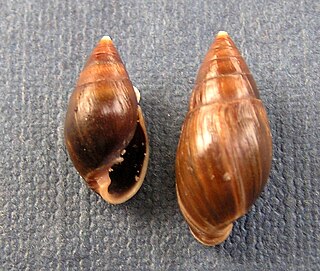
Ophicardelus is a genus of small, air-breathing land snails or salt marsh snails, terrestrial pulmonate gastropod molluscs in the family Ellobiidae.
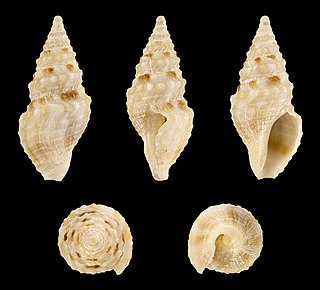
Epideira quoyi is a species of sea snail, a marine gastropod mollusk in the family Horaiclavidae.
Epidirona is a genus of sea snails, marine gastropod mollusks in the family Horaiclavidae.

Epideira is a genus of sea snails, marine gastropod mollusks in the family Horaiclavidae.

Paratrophon cheesemani is a species of sea snail, a marine gastropod mollusk in the family Muricidae, the murex snails or rock snails.

Paratrophon dumasi is a species of sea snail, a marine gastropod mollusk in the family Muricidae, the murex snails or rock snails.

Paratrophon is a genus of sea snails, marine gastropod mollusks in the subfamily Pagodulinae of the family Muricidae, the murex snails or rock snails.

Cerithidea decollata, common name the truncated mangrove snail, is a species of sea snail, a marine gastropod mollusc in the family Potamididae.
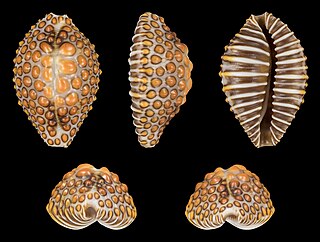
Jenneria pustulata, common name the Jenner's cowry or pustulated cowry, is a species of small sea snail, a marine gastropod mollusk in the family Ovulidae, one of the families of cowry allies.
Truncatella clathrus is a species of very small somewhat amphibious land snail with a gill and an operculum, a semi-terrestrial gastropod mollusk or micromollusk in the family Truncatellidae, the truncatella snails or looping snails. These tiny snails live in damp habitat that is very close to the edge of the sea; they can tolerate being washed with saltwater during especially high tides. These snails are sometimes listed as land snails and at other times they are listed as marine snails.

Megastraea undosa, common name the wavy turban snail, is a species of sea snail, a marine gastropod mollusk in the family Turbinidae, the turban snails. This species is native to the coast of California.
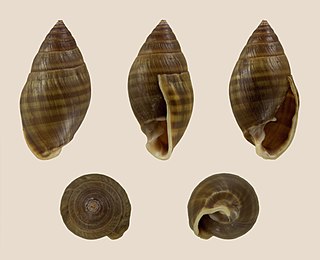
Pleuroloba is a genus of small air-breathing land snails, terrestrial gastropod mollusks in the family Ellobiidae, the salt marsh snails.

















